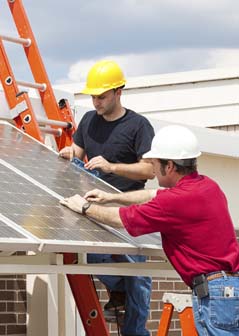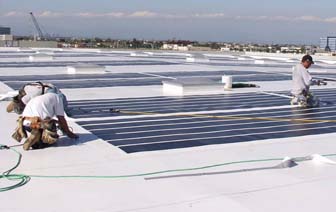How to Become a Solar Photovoltaic Installer About this section

Most photovoltaic installers learn on the job working with experienced installers.
There are multiple paths to becoming a solar photovoltaic (PV) installer, or PV installer. These workers typically need a high school diploma, but some take courses at a technical school or community college; they also receive on-the-job training lasting up to 1 year. Some PV installers learn to install panels as part of an apprenticeship.
Education
PV installers typically need a high school diploma. Some PV installers take courses at local community colleges or technical schools to learn about solar panel installation. Courses range from basic safety and PV knowledge to system design. Although course length varies, most usually last a few days to several months.
Some candidates, especially those with construction experience, enter the field by taking online training courses.
Training
Some PV installers learn their trade on the job by working with experienced installers. On-the-job training usually lasts between 1 month and 1 year. During training, PV installers learn about safety, tools, and PV system installation techniques.
Electrician and roofing apprentices and journey workers may complete photovoltaic-specific training modules through apprenticeships.
Solar PV system manufacturers may also provide training on specific products. Such training usually includes a system overview and proper installation techniques for the manufacturer’s products.
Military veterans may benefit from the Solar Ready Vets program, which is funded by the U.S Department of Energy and prepares veterans to connect with training and jobs in the solar industry.
Work Experience in a Related Occupation
Experience in construction may shorten a new employee’s training time. For example, workers with experience as an electrician, roofer, carpenter, or laborer typically already understand and can perform basic construction duties.
Licenses, Certifications, and Registrations
Some states require a license for PV installers. Contact your state’s licensing board for more information.
PV installers must travel to jobsites, so employers may require them to have a driver’s license.
Although not required for employment, certification demonstrates competency in solar panel installation. The Electronics Technicians Association, International (ETA) and the North American Board of Certified Energy Practitioners offer certification for PV installers. Some states require that for projects to qualify for solar-related subsidies, all PV installers working on the projects must have certification.
Advancement
PV installers may advance to become a project supervisor or project manager after gaining experience in the trade. PV installers may also transition to sales roles within the industry, given their knowledge of and experience with PV installation. They also may choose to start their own PV installation business.
Important Qualities
Ability to work at heights. PV installers often must work on roofs, ladders, or lifts that are far above the ground.
Communication skills. PV installers need to convey information effectively to clients, team members, and other workers.
Detail oriented. PV installers must carefully follow instructions to ensure that the system works properly.
Math skills. PV installers use algebra, geometry, and trigonometry to calculate angles, measurements, and areas.
Mechanical skills. PV installers work with complex electrical and mechanical equipment in order to build support structures for solar panels, connect the panels to the electrical system, and troubleshoot problems.
Physical stamina. PV installers are often on their feet carrying panels and other heavy equipment. Especially when installing rooftop panels, workers may need to climb ladders many times throughout the day.
Physical strength. PV installers must lift heavy equipment and materials weighing up to 60 pounds.
 United States Department of Labor
United States Department of Labor












